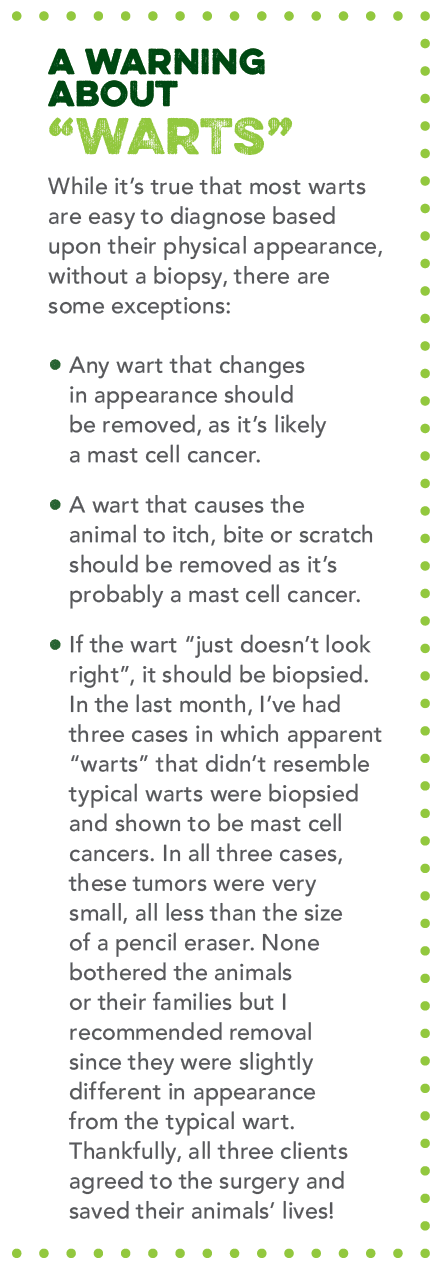5 myths about “lumps and bumps” on our pets

Lumps and bumps are common on dogs and cats, and a lot of misinformation surrounds them. Let’s bust five myths about these abnormalities so you know how to proceed when or if you find one on your own animal.
Q: My dog has a couple unusual lumps on his side. My vet says it’s probably nothing to worry about, and that it’s okay to just keep an eye on them for a while. But I’m concerned it might be cancer. What should I do?
A: Lumps and bumps are among the leading reasons animal patients are referred to me for a second opinion. Because I spent extra time in veterinary school learning about cytology (the microscopic study of cells) from two leading veterinary cancer specialists, I can aggressively evaluate all tumors, whether benign or malignant. In this article, I’ll debunk five myths about the “lumps and bumps” that sometimes occur on our dogs and cats.
Myth #1: Most lumps are cancerous
I usually refer to lumps and bumps by their more correct medical name — tumors. The word “tumor” does not imply cancer; it is just a more legitimate name for a lump or bump.
Most skin tumors in dogs and cats are benign. In my practice experience, tumors of all types tend to be more common in dogs than in cats, while skin tumors in cats are more likely to be malignant than those in dogs.
 Myth #2: You can diagnose the cause of the tumor by looking at or feeling it
Myth #2: You can diagnose the cause of the tumor by looking at or feeling it
Apparently, many doctors and clients believe this myth, and I know it has resulted in the unnecessary deaths of many animals. Yes, it’s true that “fatty tumors” are usually soft and mobile, but so are mast cell cancers. Of course, you can “guess” that the lump on your dog or cat is a fatty tumor, and you’ll be right about 80% of the time. The other 20% of the time, however, that “fatty tumor” is likely to be a dangerous and fatal mast cell tumor or sarcoma.
Unless your animal’s tumor is too tiny to aspirate, in which case it’s usually okay to monitor it, all tumors should be aspirated or removed, and then biopsied to determine their exact origin. Aspiration is quick, easy, usually painless and inexpensive, and in most cases an answer can be given within ten minutes. Keep in mind that while we wish every test was 100% accurate, this isn’t true, even with aspiration cytology – but in most cases, an exact diagnosis can be made. In other instances involving certain tumors that are usually cancerous, very few cells are aspirated, or only blood is aspirated, which makes it impossible to reach any sort of reasonable diagnosis. My rule is this: if the aspirate is non-diagnostic, especially when a large number of blood cells are seen microscopically, the tumor must be removed, as the chances of it being cancerous are quite high.
Myth #3: It’s okay to “wait and watch” lumps rather than remove them
Whenever I hear a new client say that her previous doctor recommended “waiting and watching” a tumor, my response tends to be: “Wait and watch what? The cancer spreading?”
Certainly not every tumor needs to be removed. Tumors that have been aspirated and shown to be benign may not require removal unless they grow or interfere with the quality of your dog or cat’s life. Tiny tumors that are obviously “warts” can be left alone unless they grow or irritate your animal However, any tumor that has been aspirated and shown to be something other than a fatty tumor (lipoma) or cyst should be removed and biopsied.
Myth #4: It’s a waste of money to biopsy a lump that has been surgically removed
Sometimes a client declines the biopsy after their animal’s tumor has been surgically removed. This is usually done to decrease costs, but some people say they don’t want to know if their animals have cancer. I tell them we can treat and cure most cancers, especially skin tumors, by simply relying on natural medicines, and without using conventional therapies.
Regarding cost, tumors and cancers can indeed be expensive to treat, which is a reason I strongly recommend pet insurance. However, to paraphrase my oncology teachers in veterinary school, if a tumor is worth removing it’s worth doing the biopsy. If we don’t do the biopsy, there is no way to tell whether we’ve cured the animal or only temporarily extended his life. So if you have a tumor removed from your dog or cat, do get it biopsied!
Myth #5: If the lump is cancerous, my animal will need chemotherapy or radiation
In my experience, while it’s true that some animals may need additional treatment such as chemotherapy or radiation following the surgical removal of their tumors, most do not require conventional follow-up treatment. Even if your dog or cat might require these treatments, that is no reason to watch the tumor grow.
In my practice, surgery plus follow-up supplements and herbs cure most skin tumors. For some tumors, I will inject the surgery site (ideally at the time I do the surgery, or later if another veterinarian did the initial surgery) with herbal medicines designed to kill any remaining cancer cells. In some cases, low dose chemotherapy is also injected into the tissue following surgery. For tumors that may be too large to remove, intralesional (injection) chemotherapy and/or herbal anti-tumor therapy usually shrinks it, making surgical removal much easier.
In conclusion, don’t ignore lumps on your dog or cat. While many are not cancerous, some are, and even benign lumps can grow. Understanding more about these lumps and bumps, and the myths surrounding them, will help ensure that you get the best care for your animal companion.




